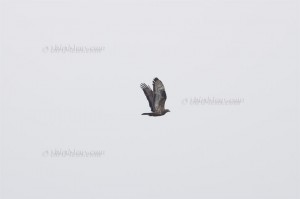 Spring is the best time to observe a flying or circling European Honey-buzzard (Pernis apivorus) on their breeding grounds. Now is Display time! Since the breeding birds arrive until the middle of May in the breeding area, bird watchers and bird photographers have to hurry-up to take pictures of European Honey-buzzards. This is because oviposition falls on the brink of May/ June. At the end of June / beginning of July, the youngs appear and at to the beginning of August fledging starts.
Spring is the best time to observe a flying or circling European Honey-buzzard (Pernis apivorus) on their breeding grounds. Now is Display time! Since the breeding birds arrive until the middle of May in the breeding area, bird watchers and bird photographers have to hurry-up to take pictures of European Honey-buzzards. This is because oviposition falls on the brink of May/ June. At the end of June / beginning of July, the youngs appear and at to the beginning of August fledging starts.
There are two periods of activity for the adult European Honey-buzzards: display and post-fledging. Display takes place in Germany from mid of May till early June. There is a time lag between spring migration observations and display flights. It seems, that on first arrival in early May the birds are rather lazy perhaps feeding and resting after the long migration. The lazy flight with long periods of effortless floating, interspersed with the very occasional stall or spell of active flapping, occurs over their breeding areas at this time. This can be misinterpreted as migration flight. In this time very impressive and repeated display flights – “butterfly display” – is brief and in rainy springs may not be conspicuous. In “butterfly mode” the European Honey-buzzard shakes its wings above back in rapid succession, usually six or seven times.
A good description you will find here. The author mentions, that in good weather the display at this time of the year might be quite obvious. The male can appear already up in the air and may call with a characteristic thin syllabic whistle. The female then comes out of the trees in a normal soar. At height the birds engage in a lot of interaction, typically alternating floating and diving at each other. The display can get wilder with one bird engaging in a series of enormous stoops across the sky, only losing a bit of height overall because of the strong bounce from the stoops. Afterwards the birds may change to the famous butterfly display
Another display feature is the follow-me pattern of flight by a pair of Honey-buzzards. In slow action one bird follows the other, faithfully copying every turn and move. This occurs particularly at high altitude in fine weather but can also occur at low altitude if the birds come out of the trees together.
Urs N. Glutz von Blotzheim in his „Handbuch der Vögel Mitteleuropas“ (“Handbook of Birds of Central Europe”), Volume 4 “Falconiformes” on page 71ff describes and points out some aspects of the display flights of the males striking, long-lasting and far-removed are recognizing the diurnal pattern of activity in flight are discussed only for the train. It is nevertheless stated that maneuvers in the actual breeding period probably are rare and the flight of the honey buzzards can be quite striking until the end of July and in the first half of August.
As I noted in practical photographic work, it may well be worthwhile to keep an eye for circling honey buzzards already in in May. The best observation time is given on nice warm or even hot weather. Although display flights do occur even in drizzle if a few decent days occur.
As also shown here in this picture sequence, the best opportunities occur especially in the later morning until noon – so from 10:30 a.m. until around 2:00 p.m.. In the early evening you might be successful again. Patience, however, is absolutely necessary and you might wait for a long period in vain. Then suddenly you might observe a male as it flies a small circ le round its breeding area, return almost immediately to disappear in the forest.
In order to satisfy the growing demand for top shots of the rarer species of Palaearctic, Bird-lens.com has undertaken targeted trips to near and distant bird areas. This is to be able to do anything to provide excellent images of the birds of the Western Palearctic. The results in images even of rare Western Palaearctic birds are very good. Very nice images bird-lens.com could bring back home are – among others – from Europe from Scandinavia (Norway, Sweden, Finland, Denmark), from Holland, from England, Poland, Austria, France, Portugal, Spain and of course from Germany.
The beautiful image of the blog was shot in Bulgaria and is only a first impression of what you will find in behind the rider “Picture- Shop” very soon. Simply enter bird-lens.com know if you need the image of a bird before new pictures are online.